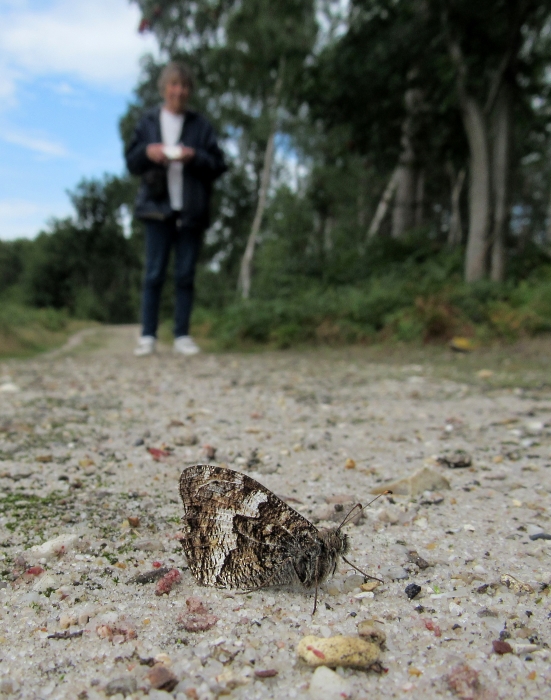Never had an egg laid on me!

I fly to England tomorrow so today was Minnie's last outing with me before going off to kennels. I decided to check out the cardinals in the valley. I had visited the site twice in July without seeing a single cardinal and once at the beginning of August, when one male had crossed my path. On all occasions the buddleia was in full flower. A friend visited a little later in August and saw five. Today they they were out in force. Arriving on site at about 12h30 I had seen half a dozen males by 12h40. From then on, males were constantly in view, sometimes in twos, sometimes threes and even fours, belting around attacking anything that moved and very, very occasionally stopping to nectar. At about 13h30 we went to a nearby spot where purple and brown hairstreaks often come down for minerals (just purple today) and spent about an hour there. During this time, more male cardinals would zoom in and out at random, never pausing but instantly recognisable in flight. I also saw a single purple emperor - probably a female - but this moved on before I had trained the camera on it. Returning to the buddleia bushes, I found the female cardinals had arrived. These spend more time nectaring and were a little more amenable - but not much, as it was hot and everything was active.
None of the cardinals was marked - some readers of my diary will remember we numbered cardinals back in May. Probably, no conclusion can be drawn from this - we started marking too late and only got 12 individuals done before they disappeared. Maybe next year ... But nevertheless it was fantastic to see so many, after none in July. It is particularly interesting because last year, when it rained pretty well solidly from the end of June to the beginning of September, cardinals were on site in July. This year, in the heatwave, they disappeared from June until August. It seems most probable they are single brooded, so the question is, what do they do when it gets hot? I suspect they go up the mountain to escape the heat in the valley, as they are known to do in some other parts of Europe. Alternatively, they might aestivate. Females are known to put egg-production on hold during July and it is possible they go all the way into diapause in really hot years. Anyway, they're back!!
Other species seen included wood white, Bath white, large white, smalll white, southern small white, green-veined white, clouded and Berger's clouded yellows, brimstone, swallowtail, scarce swallowtail, common blue, Chapman's blue, idas blue, Adonis blue, chalkhill blue, long-tailed blue, Provençal short-tailed blue, Queen of Spain, high brown fritillary, heath fritillary, silver-washed fritillary, red admiral, comma, painted lady, wall, speckled wood, dryad, tree grayling ... and probably lots of others that I have forgotten. Most of the time I only had eyes for the cardinals.
Here are a few pictures of the cardinals:

(fresh male cardinal)

(a different male, also in good condition)

(this was about the most worn male I saw)

(male underside)

(female with some wear)

(female with lots of wear)

(a third female, also showing damage to the trailing edge of the hindwing and, like most, showing a very red lower abdomen)

(undamaged female)

(both these are cardinals, the one nectaring a female and the one bombing probably also a female, judging by the condition)

(male silver-washed fitillary trying its luck with a female cardinal)
I discovered this colony, the first known colony of cardinals in Switzerland, in 2013. They survived the wettest summer in Swiss history (2014) and now seem to have survived a prolonged heatwave. It looks as though they are here to stay!!
Guy




Then another time I was concerned about something ugly and sinister on my right shoulder. It was not a twig or dead leaves, it was definitely alive as it moved ...
Slowly turning my head to look, I then saw what it was. A fully grown larva of the Lobster Moth. Gave me a bit of a scare at the time. I had been brushing through some young Beech Tree saplings and suspect it had been dislodged from one of those. Never seen one before. Quite impressive.

















































